*Update* The Root of Differences among Copy iPhone LCDs: Structure
BY Davi | 十一月 30th, 2015 | 2 | 4
As we mentioned in the previous blog, another new copy iPhone LCD would come out in market and it works good now, no negative feedback. Since cellphone repair community are still upset about the rising price of iPhone LCD screen assembly(no evidence that there will be any drop in the near feature), it won't be a bad choice to know copy iPhone LCDs’features and try some samples to test.
Furthermore, as far as we know, Apple is working on tightening their own supplying chains for after-sale service, OEM parts will be more strictly controlled by Apple. Additionally, since iPhone 5S is going to retire from the market, the OEM screens will disappear in market soon. Facing this situation, repair shops, distributors and suppliers should work together to find out the solution to meet terminal customers' demand. The copy iPhone LCDs will be a good substitute for customers who don't want to pay as much as Apple's official price.
Below are some results we got after comparing 3 main copy iPhone LCDs, including the technology, display, price, cover lens thickness and digitizers' functionality.

Structure
As we all know, the digitizer touch screen assembly in most smartphone is assembled by Glass Lens and digitizer touch screen. However, depending on the digitizer touch screen made of different material, such as glass and film, these different LCD screens have different features and performance.
TM LCD Screen
OEM iPhone manufacturers use In-cell technology to make the LCD screens, while 3rd party manufacturers have to choose other economic methods due to cost and risk. TM manufacturer adopt the G+F structure, which build the senor part on a film layer then assemble the film layer with the glass lens to be a whole digitizer touch screen. If you pay more attention to the corners of the LCD screen assembly, you can find out the film edge and rip it apart.
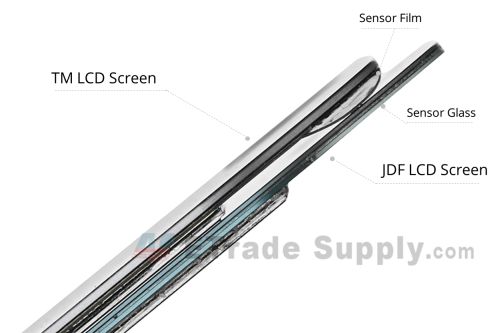
LT LCD Screen
As we mentioned in the previous blog, LT manufacturer use the OGS technology to make the digitizer touch screen. The touch sensor is embedded on the glass lens and the cover lens is made very thin to make sure the digitizer work as good as possible to receive the command from fingers. The LT LCD screen is so thin that we can see the dots and diamond textures beneath the cover lens.
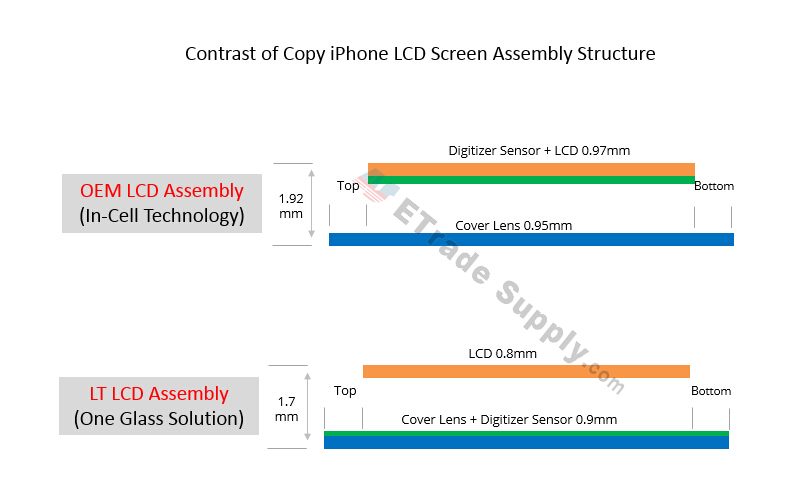
JDF LCD screen
JDF manufacturer use the G+G structure for its LCDs. G+G means glass plus glass. The digitizer touch sensor is made on a glass lens then the glass assembled with the cover lens as a whole digitizer touch screen assembly. Apparently, this kind of structure will increase the thickness of the digitizer touch screen, but it makes it possible that when the screen break, the digitizer screen works as usual. In the opposite, once the LT OGS LCD screen breaks, the whole LCD screen assembly goes bad, and it can't be repaired except replacing the whole part. By the way, the G+F and G+G structures both help prevent the bad situation. The G+G structure also helps light to come across the screen so that we can feel the display more bright and transparent. As far as we know from our supply chain partners, Apple iPhone 7 may use G+G structure on the screen.
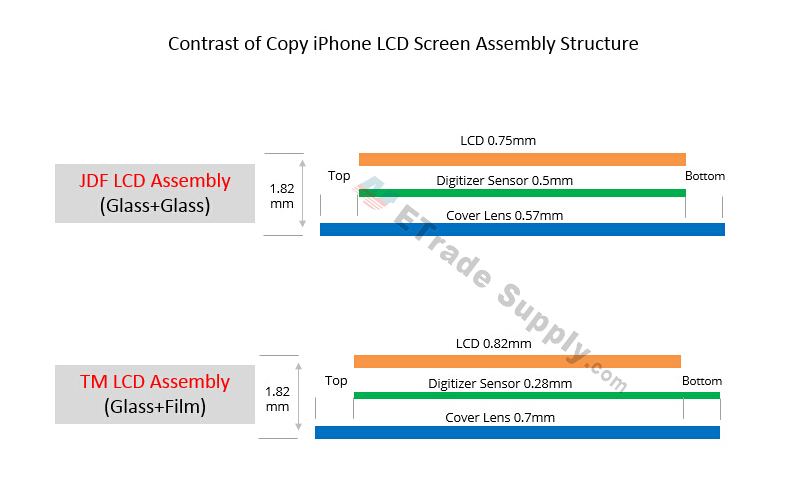
TM LCD screen and JDF LCD screen both have a better solution for accidental screen break by building digitizer sensor on film or glass, however, as a coin has its two sides, though the G+F structure has a thinner digitizer touch screen, the film material is not good for light reflection, meanwhile the light cross through glass much easier on JDF screens. The difference lead to the different display performance.
From the contrast in the 2 pictures above, we can find only the LT and TM stretch the digitizer to the bottom, that's why LT and TM LCD assemblies has a smooth surface on the bottom part around the home button. That’s a tip for cellphone repair community to figure out TM and LT LCDs from others. Below is also a contrast for you guys to check.
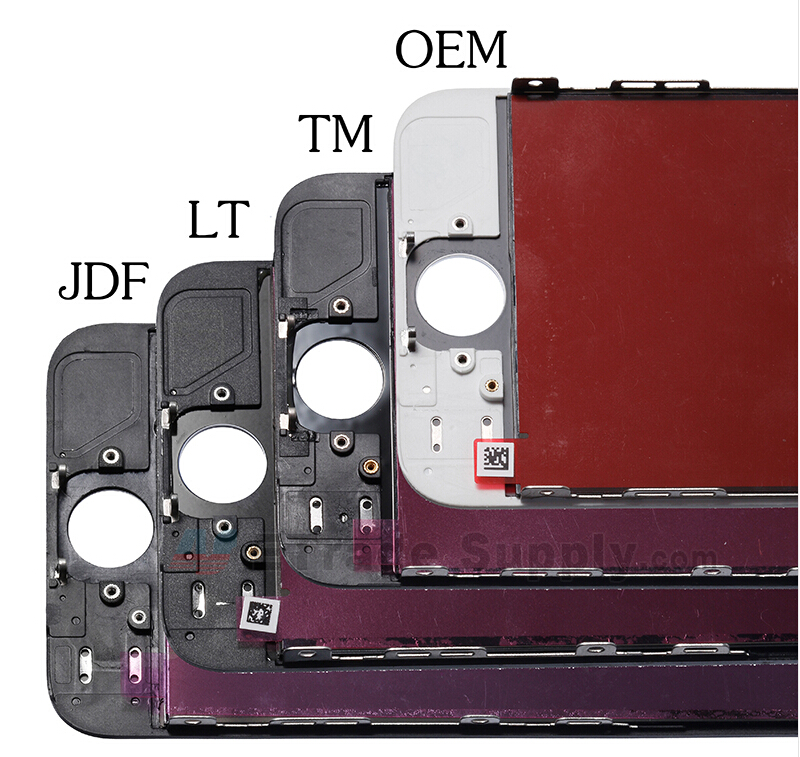
We also tested the color display performance, as we listed in the chart, generally speaking, the TM performs best among the copy parts while the JDF LCD screen display shows yellowish, but it doesn't affect the daily usage.
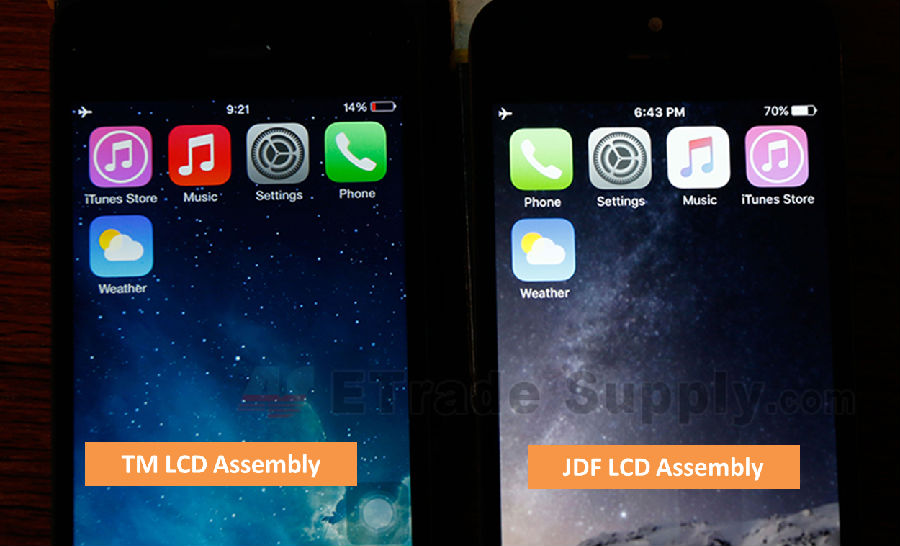
Any questions, please feel free to contact us at service@etradesupply. Join our repair community to get more informative knowlege and gain skills. We also happy to see any feedback of our blogs from you to help us advance. Please comment below to let us know. Thanks.
Also Interested in our wholesale business and want to do business with us? Please sign up our cellphone parts wholesale program and check our Memebership System, which explains how we work with our business partners and what's the privileges for you.
Related Blogs:
- Important Info: Pay Attention To Defective Recycled iPhone LCDs
- Update: Don’t Miss the Copy iPhone LCDs’ Features
- How to Tell The Copy Parts From OEM (Without Tear Down the LCD Part)
- Are The Flood of New High Copy iPhone LCD Screens as Good as The OEM Ones?
|
|

|

|

|

|

|
|---|











